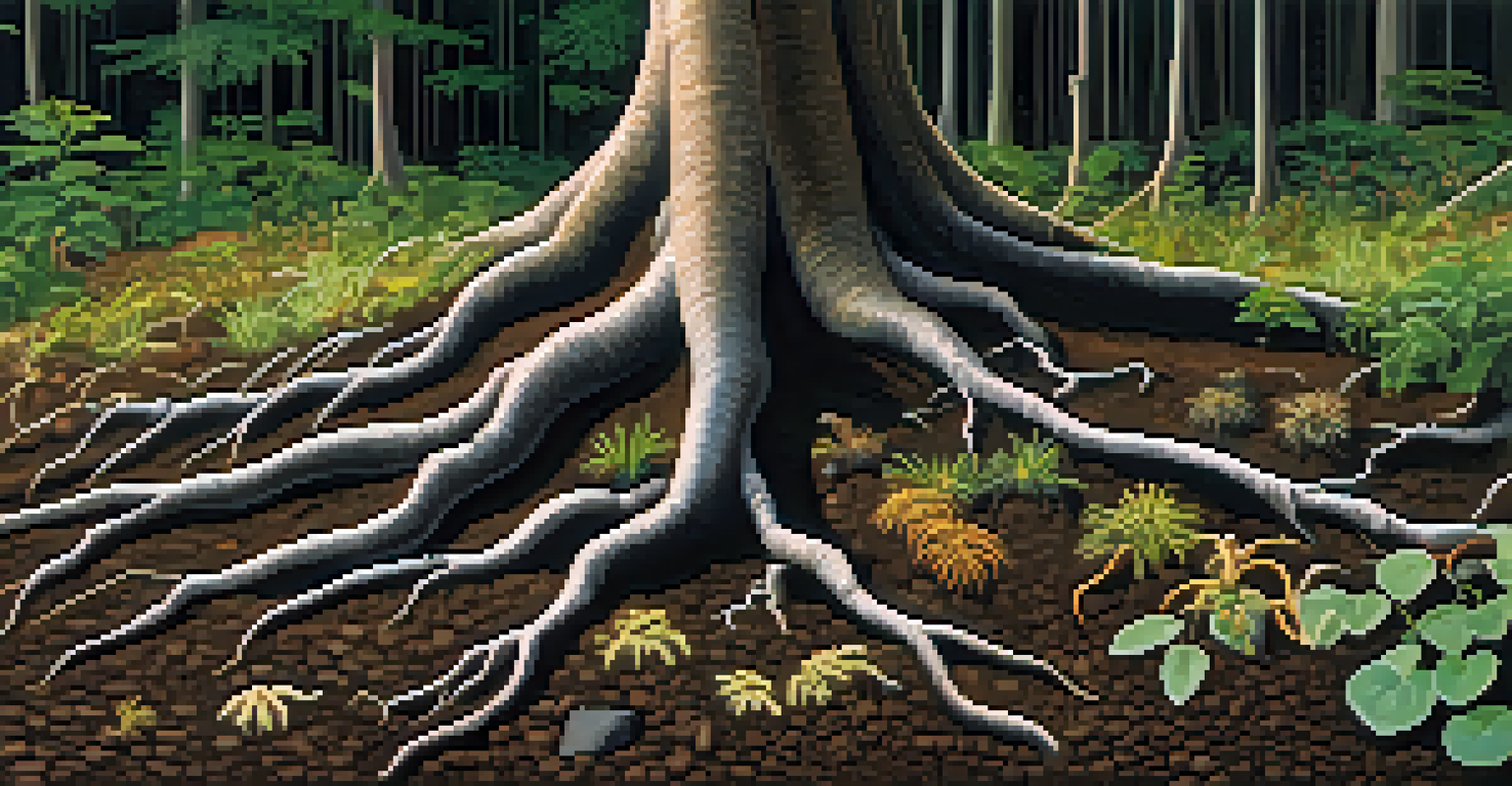Why Native Plants are Essential for Soil Health and Stability

Understanding Native Plants and Their Benefits
Native plants are species that have evolved in a specific region over thousands of years. They are adapted to local conditions, which means they thrive without needing excessive water, fertilizers, or pesticides. This natural resilience not only supports local ecosystems but also promotes biodiversity, which is crucial for maintaining healthy soil.
The creation of a thousand forests is in one acorn.
When we integrate native plants into our gardens or landscapes, we create a habitat for various wildlife, including beneficial insects and pollinators. These organisms play a pivotal role in soil health by aiding in decomposition and nutrient cycling. Essentially, native plants serve as the foundation for a balanced ecosystem, fostering an environment where soil can thrive.
Moreover, native plants require less maintenance, making them a sustainable choice for gardeners and land managers. By reducing the need for chemical inputs and extensive irrigation, we can protect soil health while saving time and resources, ultimately leading to more resilient landscapes.
How Native Plants Improve Soil Structure
The roots of native plants are typically deep and extensive, which helps to aerate the soil and improve its structure. This aeration allows water and nutrients to penetrate deeper into the ground, preventing runoff and promoting healthy root growth. A well-structured soil is essential for supporting plant life and maintaining a balanced ecosystem.

Additionally, the organic matter produced by native plants, such as fallen leaves and decaying roots, enriches the soil. This organic matter acts as a sponge, holding moisture and nutrients that plants need to thrive. Over time, this natural process leads to healthier soil, which can support a greater diversity of plants and wildlife.
Native Plants Enhance Soil Health
By improving soil structure and nutrient cycling, native plants create a robust foundation for healthy ecosystems.
By fostering soil structure, native plants help combat erosion, which can be a significant issue in areas with poor vegetation cover. Their strong root systems anchor the soil, reducing the risk of loss during heavy rains or winds, thereby contributing to greater soil stability and health.
The Role of Native Plants in Nutrient Cycling
Native plants play a vital role in nutrient cycling, which is the movement and exchange of essential elements in the soil. Their roots not only absorb nutrients but also contribute to the soil's nutrient content through the decomposition of organic matter. This cycle ensures that the soil remains fertile and capable of supporting diverse plant life.
Nature does not hurry, yet everything is accomplished.
Certain native plants have unique relationships with soil microbes, forming symbiotic partnerships that enhance nutrient availability. These interactions can improve soil fertility, making it easier for other plants to access the essential nutrients they need. Such plant-microbe partnerships are vital for maintaining the health of the soil ecosystem.
By promoting these natural processes, native plants help create a self-sustaining environment. This reduces the need for artificial fertilizers, which can lead to soil degradation and pollution, highlighting the importance of incorporating native species in landscaping and agricultural practices.
Preventing Soil Erosion with Native Plants
Soil erosion is a major concern in many regions, leading to loss of fertile land and increased sedimentation in waterways. Native plants are incredibly effective at preventing erosion due to their robust root systems that bind soil together. This natural anchoring helps to create a protective barrier against wind and water erosion.
When native plants are established, they provide ground cover that shields the soil from the impact of heavy rains. This cover reduces the speed at which rainwater hits the ground, allowing it to infiltrate the soil rather than wash it away. Consequently, landscapes with native plant cover are less susceptible to erosion.
Preventing Erosion with Deep Roots
The strong root systems of native plants effectively anchor soil, reducing erosion and promoting stability.
Moreover, restoring native vegetation in eroded areas not only stabilizes the soil but also facilitates the recovery of disturbed ecosystems. By reintroducing native plants, we can help restore the natural balance, preventing further erosion and promoting overall soil health.
Enhancing Soil Moisture Retention with Native Plants
One of the remarkable features of native plants is their ability to retain soil moisture. Their deep root systems allow them to access water that is unavailable to shallower-rooted plants. This characteristic is especially important in regions prone to drought, where soil moisture can mean the difference between a thriving ecosystem and a barren landscape.
In addition to their water retention capabilities, native plants contribute to the formation of a mulch layer through fallen leaves and organic debris. This natural mulch helps to insulate the soil, reducing evaporation rates and keeping the soil cooler during hot weather. Ultimately, this means that moisture levels remain more stable, benefiting both plants and soil health.
By promoting better moisture retention, native plants can lead to healthier soils that support a wider variety of plant species. This biodiversity helps create a more resilient ecosystem, capable of withstanding the challenges posed by climate change and shifting weather patterns.
Supporting Biodiversity with Native Plants
Biodiversity is the cornerstone of a healthy ecosystem, and native plants play a crucial role in supporting this diversity. They provide habitats and food sources for a wide range of organisms, including insects, birds, and mammals. This variety of life not only enriches our natural surroundings but also contributes to improved soil health through natural processes like pollination and nutrient cycling.
When native plants are included in landscapes, they create a balanced ecosystem that promotes interactions among different species. This interconnectedness helps to stabilize populations and prevent the dominance of any single species, which can lead to imbalances and soil degradation. A diverse ecosystem is more resilient to pests, diseases, and environmental changes.
Support Biodiversity with Native Species
Integrating native plants fosters biodiversity, which is crucial for maintaining balanced ecosystems and healthy soil.
Furthermore, preserving native plant species can help protect the unique genetic resources they offer. This genetic diversity is essential for adapting to changing environmental conditions, ensuring that ecosystems remain robust and capable of supporting future generations.
Conclusion: The Importance of Native Plants for Soil Health
In conclusion, native plants are essential for maintaining soil health and stability. Their unique adaptations and relationships with the local environment create a foundation for healthy soil ecosystems. By improving soil structure, enhancing nutrient cycling, and preventing erosion, native plants contribute to a more sustainable landscape.
Integrating native plants into our gardens, parks, and agricultural practices not only benefits the soil but also supports biodiversity and resilience. As we face increasing environmental challenges, recognizing the value of native species is more important than ever.

Ultimately, nurturing native plants can lead to healthier, more stable soils that provide vital resources for both current and future generations. By prioritizing native vegetation, we can promote a thriving ecosystem that benefits us all.